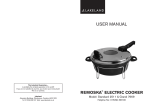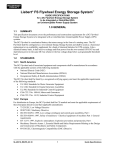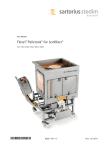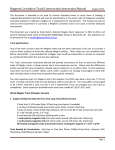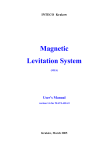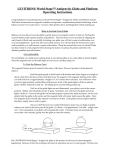Download Experiments with an induction cooker 2
Transcript
Experiments with an induction cooker Experiments with an induction cooker Peter Zilavy Charles University in Prague, Faculty of Mathematics and Physics, V Holesovickach 2, Praha 8, 180 00, Czech Republic E-mail: [email protected] Abstract. The induction cooker is a common appliance nowadays. How does it work? Why is it not possible to use aluminium pottery with it? And what experiments can be made (at different levels) with it and not only in physics lessons? The search for the answer to this and other questions is the content of this article. 1. Introduction A few years ago, a new household help – the induction cooker was being offered in the supermarkets and internet shops (e.g. [1]). The commentary of the internet vendor, as well as the user's manual, [2], says: The element of the induction cooker, as can be learnt from the name, is the induction coil (electromagnet), placed under the ceramic plate. It creates, together with the bottom of the pottery, an electromagnetic circuit, which causes only the bottom base of the utensil to be heated by the plate (98% of the electricity is converted into heat). By using the common electrical equipment (electric cooker, common glass-ceramic plate) the heat has to pass through the plate and than it transmits the energy into the utensil, which is used for cooking. Huge energy dissipation is involved in each energy transmit. The induction cooker, in comparison to the others, doesn't emit any heat and it cannot therefore burn any food. Cooking is much faster and more economical than any other method used. Induction cooker - utensils It is necessary to use the utensils made from conductive, magnetised material as cast iron, enamel and other specialized materials with a flat bottom, which can be 12-30 cm in diameter. Cooking is completely safe as the surface of the plate remains cold during cooking. www.tvproducts.cz Except for the part about non-burning of the food, everyone with at least a bit of physics, is interested in the information of the necessity to use the special, magnetized utensils. Why are aluminium utensils not possible to be used, if the variable magnetic field can create there the eddy currents in the same way as in iron? Is the need of ferromagnetic material important? Can the induction cooker be used in physics lessons to do demonstrative experiments? The answer obtained by experiments is offered in the next paragraph. 2. Description The induction cooker used for the experiments is equipped with the glass-ceramic plate and under it, there is the flat coil situated (densely winded), glued to plastic basement. The coil is connected to the source of pulsation with the frequency of about 25 kHz (measured by one-turn loop on the oscilloscope probe close to the coil). 1 The elementary operation is easy – after placing the pot (not empty) onto the plate, press the ON/OFF switch of the cooker and after cooking, switch off with the same switch. The capacity of the plate can be changed using the buttons with arrows. Never use an empty pot – it heats fast and can be damaged due to that. In case the cooker is switched on without any pot, there is a warning note showed shortly after with a warning sound (beep) and the cooker is switched off. In case the wrong type of utensils is used, the procedure is repeated. The protective function of the cooker can prevent it against most misuses. 3. The Induction Cooker Exploration An iron (metal sheet) pot with approx. 0, 05 l of water (to cover the bottom) has been placed on the plate and the cooker was set to the capacity of 1200 W. The water started boiling shortly after (10 15 seconds). By this, the elementary function of the cooker was showed. The previously mentioned “experiment“ was repeated, but the pot was placed on the plate using the wooden grid at the height of 1 cm (the same which is used when you want to place something hot on the table) or using the poly-styrene board of the same height. Water started boiling shortly after switching on again. Immediately after taking the grid (the board) away, the temperature of the plate is possible to be tested – the plate is cold. In the case of the induction cooker, the temperature is not transmitted by conducting or radiation, the eddy currents induced in material can heat it directly thanks to Joule heat. The thick aluminium plate was used instead of the grid (the pot was placed into the aluminium pan or the aluminium bottom of Remoska) and the previous experiment was repeated. The cooker announced an error and started beeping. The same behaviour was showed when only water was in the pan and the cooker was switched on (the standard aluminium utensils was used). The experiment showed that the cooker was sensitive to the presence of well-conductive aluminium (it announced an error even in though there was an iron pot placed in the pan). We got back to the iron pot (without the wooden grid), and a thin aluminium foil was placed upon the whole surface of the plate under it. After switching the cooker on, the foil was heated more than water – the water was heated slower than before. After taking the pot and the foil away, the plate was very hot. As a next step, we tried to place only the foil back on the plate. After switching the cooker on, it levitated and it was not caused by hot air! (Remember the school experiment with aluminium ring 2 Experiments with an induction cooker to demonstrate the Lenz law). When we than held the foil (without cooling by the pot) on the plate, it was glowing white in some places, started to melt and sparkle. It seemed the thin foil didn't load the cooker so much to switch it off by the integrated protection. Next, we placed the pot made of non-ferromagnetic stainless steel (proved with a magnet) without a sandwich bottom (plain metal sheet). The water started to boil without any problem. We repeated the experiment with ”a luxurious“ stainless steel pot with thick sandwich bottom (probably made partly of aluminium for better heat distribution), the cooker announced failure and switched off, beeping. In case you hold the stainless steel or iron pot with a small amount of water in your hands above the plate, you can feel the alleviation of the pot. The same happened to the foil, also. Based on the above mentioned experiments we can say the pot is heated mainly by the eddy currents induced in material (as it works with conductive non-ferromagnetic materials, we can say more than hysteresis losses or other mechanisms). The material of the pot cannot be too conductive – the cooker is than overloaded and switched off by the protection. In case the aluminium pan (pot) approaches the cooker coil, it works the same as if the secondary winding of the transformer is short-circuited. The primary winding leads higher current that can destroy the transformer. The cooker has the protection for that reason that detects the exceeding current and switches off the coil source, together with the failure notice. (It works the same way as if there is no pot on the plate – there is no consumption on the „secondary“ side). Warning: multilayers of aluminium foil (tried with 8 layers) led to the coil source switching transistor destruction. This is repairable damage. 4. Experiments in Physics Lessons The following experiments, demonstrating some elementary electromagnetism principles, were inspired by the already described cases. 4.1. Levitation of Copper Ring Copper conductor (wire) the diameter of 1 mm2 was coiled into a loop with the diameter of 10 cm and connected by a clamp. A small metal pot was filled with a little water (so not to overheat it) was placed on the plate inside the copper circle. After switching the cooker on, thanks to the magnetic forces affecting the ring by the induced current, the ring took off. The experiment cannot last too long as the ring is enormously heated (in case an insulated wire is used, the insulation melts therefore it is not wise to solder the ends of the loop). The pot serves as “consumer “for the energy as the protection doesn't switch cooker off. 4.2. Cooker as Transformer The copper ring from the previous experiment is disconnected (another can be used, also) and the bulb socket is placed in the clamp position. A light bulb of 6 V (e.g. 0,1 A) is used. A coil with one winding powering the bulb is created. After placing this coil on the plate of the cooker and placing the pot from the previous case above the plate (it helps us again to overcome the protection) the bulb started shining. We have created a transformer. The primary winding is the coil of the induction cooker and the secondary coil is the winding of the ring with the light bulb. Thanks to the high magnetic field changes frequency there is no need of a magnetic circuit which transfers the magnetic field to the coil. 3 The experiment was successfully repeated with a light bulb 24 V / 100 W (the whole class can see it). The light bulb 24 V / 100 W can be purchased in any wholesale shop. For that purpose, we used the coil in diameter 11 cm (a plumber pipe can be used) made of four turns of insulated conductor of 1mm2 size. This coil is connected to the bulb socket. The light bulb 230 V / 100 W can be used, too, but then it is necessary to make the coil with 40 turns (you can notice it corresponds to the induced voltage of approximately 6 V per turn). The coil should be made of a thinner conductor (it is recommended to use the wire from network cabling or bell-wire), for the turns are 1 cm maximum above the plate surface after the coil is placed at the plate. If the wire is too thin (enamelled wire), it can be burnt by the induced current. While performing the experiment, it is necessary to pay attention as we are working with dangerous induced voltage (even though the coil has “only“ 40 turns)! We can only touch the bulb socket, not the wires which are not sufficiently insulated. 4 Experiments with an induction cooker The last experiment was done with the largest easily available light bulb 230 V / 0,5 kW. The same coil as in the previous experiment was used (40 turns), but a larger socket is necessary (equipped by thread E40). To light the bulb, we have to use the pot with the water. After taking the pot away, the bulb remains lit up – the consumption of the bulb is recognized as sufficient to be seen as regular pot on the surface of the plate. 4.3. Observing Damped Oscillations The single loop of the oscilloscope probe is connected to the digital oscilloscope and approached to the plate (it is enough to connect the grounding conductor of the probe to the tip). The oscilloscope was set to display the singe events, or the mode Normal (repeated display of voltage course, but only after reaching the indicated value). The plate remained without pot and the cooker was switched on. The oscilloscope display showed the course of damped oscillations. The level of damping can be reduced by approaching a small pot to the plate. 5 Explanation: There is a parallel connection of a capacitor and an induction coil inside the cooker, creating a resonant circuit. Shortly after switching the equipment on, the inductive coil is connected to the power supply for a short time by the transistor (rectified low filtered voltage of the power network). During this time, based on the voltage of the coil, the equipment evaluates whether there is an appropriate pot on the plate. In case of a positive result, the switching process repeats with the frequency of approximately 25 kHz. If negative (or if we take the pot away), the electronics tries to connect the coil after several seconds. This is the mode in which we can see damped oscillations in the resonant circuit, arisen from short voltage pulse. In case we approach the metallic object to the cooker coil, the energy arisen during the voltage pulse is led to it thanks to the electromagnetic induction. The oscillations disappear faster, the circuit is more damped. 5. Conclusion Iron (enamelled) utensils without any highly conductive (electric and heat) aluminium layer can be used to cook on the induction cooker. The heating is caused by eddy currents induced in the material of the pot, the utensils definitely needn't be magnetised (as stated in the manual) or made from ferromagnetic material. The above mentioned experiments can be the inspiration for many other experiments using the induction cooker. The available capacity of the cooker enables us to do impressive experiments, but many of them require close attention. Special notice: Pay attention at any conductive rings on your hands if you handle any objects in the distance of some centimetres above the plate. Short influence of the electromagnetic field on your hands is not dangerous, but well conductive ring in appropriate position can be heated to high temperature in few seconds. 6. References [1] http://www.tvproducts.cz [2] Induction cooker – user's manual (delivered with the equipment) 6






